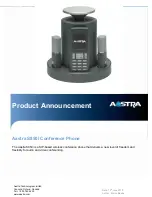
Chapter 4 | During Your Videoconference
This chapter describes the different actions available during your videoconference, such as recording the
videoconference or sharing content with other participants:
Navigation
•
•
Controlling your Video and Audio
•
on page 69
•
on page 73
•
Saving Content from the Videoconference
Recording a Videoconference
This section describes how to record videoconferences. You can define the recording settings, such as
the recording bitrate to determine the recording's file size, and how to view recordings from the XT
Series web interface.
Navigation
•
Setting Your Recording Preferences
•
on page 58
•
Viewing a Recording from the Web Interface
Setting Your Recording Preferences
About this task
You can record videoconferences and store them to a connected USB storage device. This procedure
describes how to configure your recording preferences, such as the video resolution and bitrate. This is
useful, for example, to increase the time available for recording on your USB storage device. You can do
this procedure from the endpoint itself or from the XT Series web interface.
This may require a license, depending on your model. For more information, see
Installation Guide for
Scopia XT Series
.
You can play the recordings using any standard media player. The system saves the file as an MP4, and
records the video in H.264 format and audio in AAC-LC format.
You cannot record videoconferences when encryption is enabled. For more information, see
Administrator Guide for Scopia XT Series
or contact your administrator. When recording a
videoconference on a system with an embedded MCU, you can include up to 4 remote endpoints. The
Scopia XT Series SMB Edition edition can include up to 4 remote endpoints.
User Guide for Scopia XT Executive Version 3.2
During Your Videoconference | 56
















































